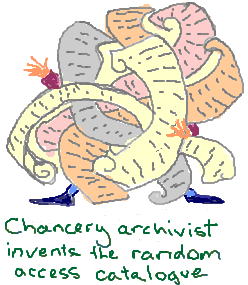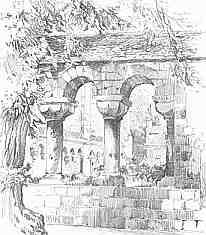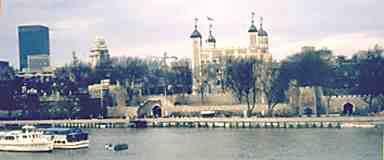





If you are looking at this page without frames, there is more information about medieval writing to be found by going to the home page (framed) or the site map (no frames).
| English Chancery Records (2) | |||
| It seems that once started, this archiving process rapidly proliferated. Within a very few years there were separate charter rolls, patent rolls and close rolls, for copies of charters, letters patent and letters close respectively. These divisions are only approximate, and really represent different rolls for documents of different significance. Charters represented significant grants in perpetuity. The terms letters patent and letters close strictly refer to whether the letter was delivered open, with the seal appended, or closed with sealing wax. This roughly approximates to their public significance, but some writs of an ephemeral nature were delivered open as public documents, but entered on the close rolls as items of lesser importance. | |||
 |
|||
| An entry from the Patent Roll of 1201/1202 (London, National Archives, Patent Roll II, m.3). (From Johnson and Jenkinson 1915) | |||
 |
|||
| A few lines from a Charter Roll of 1340 (London, National Archives, Charter Roll 127, m.4). (From Johnson and Jenkinson 1915) | |||
 |
|||
| And a little spasm from a Close Roll of 1389 (London, National Archives, Close Roll 230, m.2). (From Johnson and Jenkinson 1915) | |||
| OK, OK, I know those are too small to read, but they are just a little visualisation to indicate that these things are real. For the enthusiasts, I will try to put in some paleography exercises on these documents, drawing almost entirely from Johnson and Jenkinson, which is, I believe, still the only published source for learning how to read the chancery rolls. I assume aspiring researchers still use this source, or sit at their tutor's feet with a pile of photocopies. | |||
| In addition to the three main series of rolls, there were others, such as the Fine Rolls which registered sums of money promised to the king in return for grants of land, and the Liberate Rolls which recorded authorisations to the Exchequer of payments of money. Partial series of rolls were made for matters pertaining to particular territories, such as Gascon, French and Scotch Rolls. | |||
| There were some problems with this as an archiving system. One was in the nature of the rolls themselves, which were written on both sides and had no indexing system, apart from brief marginal headings on the left of entries, as shown above. It was really only possible to look up the rolls efficiently if the exact date of issue of the document was known. Being metres long, the process of physically wrestling with the beasts made searching awkward. |
 |
||
| While the use of a roll might be seen as a method of combatting fraud, the standard of entry tended to negate this, with corrections and erasures scattered through them. They were evidently often entered from drafts of the document, which might be altered before it was sent out, so that the details of known documents do not always exactly match their entry on the rolls. They are also incomplete. Some classes of letters patent, for example, were only enrolled if the beneficiary paid for the privilege. | |||
 |
The other problem was the location of the archives. Before the Norman Conquest charters were deposited in the king's sanctuary, located either at Westminster or Winchester. The Domesday archives were reportedly kept in a treasury at Winchester, but they subsequently disappeared. During the 12th century, it seems that Winchester continued to serve as a central archive for important royal documents. The royal treasury housed not only documents of value, but the valuable objects which accord more closely in the general imagination to the concept of treasure; jewels, plate and the like. | ||
| Norman cloister at Winchester Cathedral. | |||
| During the reign of Henry II, just as bureaucratic processes were beginning to develop, the central treasury and archive were abandoned. The court was regularly on the move, and valuable documents were lugged about from place to place along with the tapestries and catering facilities. King John continued this pattern, with the bulky newfangled Chancery rolls toted about the land and occasionally deposited for safekeeping in a nearby abbey. This may explain why so many of the loose documents of earlier times, as opposed to the rolls, were lost. | |||
| As the piles of parchment mounted, this peripatetic archiving system became impractical and permanent archives were set up. The Tower of London, the New Temple and Westminster Abbey appear to have become the main repositories in the 13th century. The Chancery acquired premises in 1290 in what is now called Chancery Lane. When the Knights Templar were dissolved in 1312, it seems that the Tower of London became the primary depository. In the 1320s, all the records of the Chancery and Exchequer were carted off to the Tower of London for a good sorting out, and redistributed again. | |||
 |
The Tower of London. | ||
| As the significance of the written word in law and governance increased, the processes of literate government, and the written records they produced, became more complex. | |||
If you are looking at this page without frames, there is more information about medieval writing to be found by going to the home page (framed) or the site map (no frames). |
|||